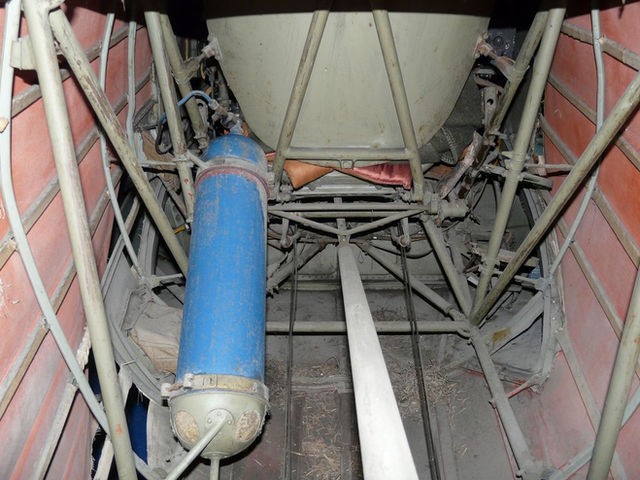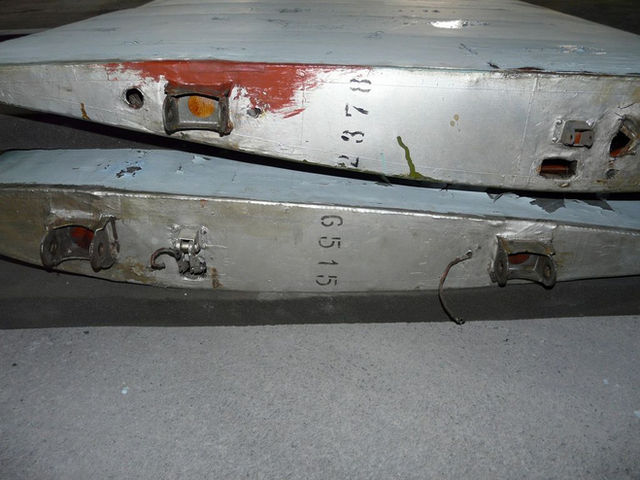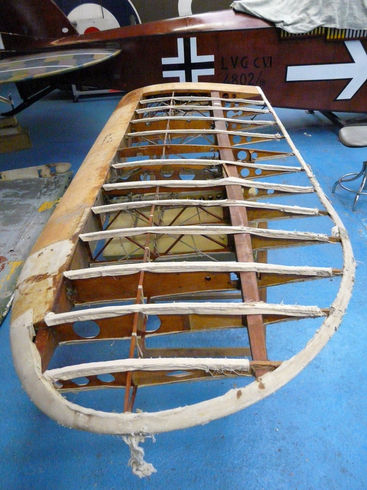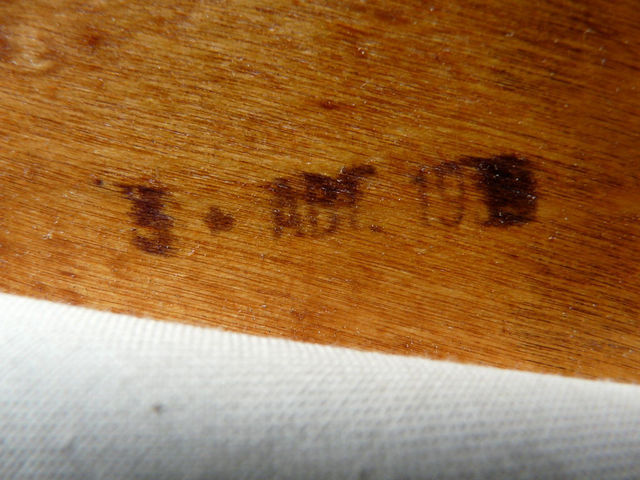

The Polikarpov I-153 is a single seat fighter biplane that first flew among the Soviet air forces (VVS) in 1939. It was nicknamed "Tchaïka" (Чайка : Seagull) due to its gulled upper wing. Powered with a 1000 hp Chvetsov M-62 engine, the I-153 was armed with 4 7.62mm ShKAS machine guns installed in the fuselage. Its landing gear was classic, with a retractable main gear. Some aircrafts were also fitted with a ski landing gear. More than 3300 aircrafts were built during WW2.
Polikarpov I-153 #7277

This Polikarpov I-153 has belonged to the French Musée de l'Air since the early 1950's. The museum now has offered Memorial Flight the opportunity to restore this unique aeroplane.
Any restoration needs a long and thorough investigation work. It was quickly found that this aircraft is, as a matter of fact, a composite assembly made from several I-153s. The serial number that was most found on the fuselage is 7277, but the rudder bears the number 7396. The fabric and the painting were also closely studied, as well as fuselage parts, cowls, etc.
Memorial Flight has been in touch with Russian historians. They found that I-153 #7277 was built in Moscow and delivered to the VVS with Chvetsov M-62 #1474 engine on January 1940 24th. It was part of 238 IAP and based in Lithuania when captured in 1941. Reassembled by the germans, using any parts available, it was then partially covered with new fabric and probably repainted with fake VVS markings. This I-153 was very likely static displayed in Luftwaffe technical parks (Beutepark), and travelling from parks to parks ended up in Beutepark d.Lw.5, and displayed amont its little museum. This park was located in Nanterre, near Paris, and was liberated in 1944. It was on display along many other allied aircrafts (mainly coming from the westen front, but it was also displayed next to a MiG-3).
How and why this aircraft survived is still mystery. Several stories have been told, and there is a rumor saying that, once liberated, some C.G.T. (a French trade union center, that supported USSR and communist ideology) delegates among the workers supported safeguardind this aircraft because of the red stars it bore. However this does not explain why the MiG-3 knew a different fate and was likely destroyed... The only certainty is that this I-153 arrived among the Musée de l'Air's collection and was displayed at Chalais-Meudon in the early 1950s.
What happened between 1944 and 1950 remains unclear so far...
A colourful history

The Musée de l'Air Polikarpov I-153 has always been displayed to the public with an approximative paint scheme : olive green fuselage and top surfaces with blue lower surfaces. The tail bore a red "9" painted on the rudder.
Memorial Flight's investigation started by slowly stripping the paint, layer by layer on several parts. It was quickly found that the aircraft's original paint scheme was aluminum doped fabric and (grey paint on metallic parts), typical for that aircraft at the very beginning of the war. Russian historians helped us doing extensive researches and providing unknown details about the aircraft's operational history, completing the findings made by studying the aircraft itself. Here are the different colours applied to the I-153 #7277 :
-
Aluminum doped fabric and grey paint on metal parts. This was the original colours sported by this I-153 when delivered on January 24th 1940. The airplane likely saw action during the Winter War between USSR and Finland which took place between November 30th 1939 and March 13th 1940.
-
On August 20th 1940, this aircraft was part of the 15 IAP fleet. This fighter regiment was based in Lithuania, as parf of the 8th SAD (mixed aviation division), attached to the Baltic military district.
-
On January 1st 1941, most of 15 IAP aircrafts were transferred to 236 and 238 IAP. #7277 was thus transferred to 238 IAP (6th SAD, Baltic military district), based in Panevezys [Ponovezh], Lithuania. This airfield being taken on June 26th 1941, #7277 (likely out of order) was captured along many other aircrafts. At this time, a large "21" number was painted on the vertical stabilizer and tail, below a red stripe (underlined with a black line). It seems the aircraft was already disassembled, and only its fuselage (as well as some cowls, but without its rudder) survived.
-
-
Green RLM 62 paint. After being captured, #7277 was "re-assembled" by the Germans replacing the missing parts with other I-153 elements (as confirmed by the numerous part numerous different part numbers found). The fabric, which was largely tore off, was "repaired" stitching a new fabric over it. Those repairs are easily recognizable as a German typical red dope was used to tighten the new fabric parts. Once "repaired", the aircraft was painted RLM62 green, except for lower sufaces that were painted blue. This seems rather like a strange choice, as many parts still had the original paint scheme prior to this repaint. Did the staff that took care of those repairs lacked aluminum paint / dope, or were they ordered to give it new look ? However, it should be noted that the "newly installed" rudder, which came from a different airframe, bore an original VVS green paint, with a "9"identification number painted on it (outlined in white).
-
"Musée de l'Air" green colour. When displayed in the 1950s by the Musée de l'Air in Chalais-Meudon, a square piece of the fabric was missing on the left side of the fuselage, where the red star was painted. The museum then repaired the aircraft, patching up a piece of fabric, once more, between 1954 and 1962. This may be when the aircraft got its last coat of paint (still green with blue lower surfaces). This is the paint scheme that had been seen by the public until the aircraft arrived in Memorial Flight workshop in 2011.
A detailed article was written and published in the French Fana de l'Aviation magazine in June 2011 (issue #499). It explains the study and research done, and shows many photos of the process.
The Restoration
Photoscope
Photoscope
Polikarpov I-153 cockpit, prior to restoration.
Though the cockpit is not 100% complete, very few parts or instruments are missing.
The central panel of the dashboard looks white because of the missing black bezel which covers it. This bezel is meant to hide the dashboard lights.
Note the blue pressured air bottle which bears the Luftwaffe inspection stamp made in January 13th 1942 "UNBRAUCHBAR 13.1.42", meaning that this bottle was unusable.
Photoscope
Lower left wing prior to restoration.
This wing (as well as the others) did not originally belong to #7277 airframe. It was likely mounted on this aircraft after it was captured by the Germans.
The serial number 6515 was painted on the wing root This wing also has a manufacturer plate indicated it was checked out on August 28th 1939.
Pieces of history
Identification
The Musée de l'Air Polikarpov I-153 is a mix of several aircrafs. Thus, Memorial Flight investigated to find out the fuselage identification.
The serial number found on many different locations of the fuselage, either painted or stamped is 7277. This is how the Musée de l'Air aircraft finally got identified.
Capture
The I-153 #7277 fuselage was captured on Panevezys [Ponovezh] airfield, en Lithuania, along with similar airframes.
It was then convoyed by the Germans on a train (to an unknown location). A photo was found on the Interned showing this very same fuselage on a train flatcar. We only have a low resolution version of this photo, but the yellow number "IV" in Roman numerals can be seen painted on the vertical stabilizer, as well as the number "2" (which was in face a unit code "21") painted exactly like #7277. No doubt that this is the same fuselage.
The first picture shows the fuselage on the train flatcar. the second one shows another I-153 from the same unit bearing the number "25", when found by the Germans on the airfield. Finally, the third photo shows the rudder, partially paint stripped by Memorial Flight depicting exactly the same characterstics as the first photo.
Specifications
Length: 10 m
Wingspan: 6.18 m
Weight (full charge): 1859 kg
Engine: 1000 hp Chvetsov M-62
Top Speed: 426 km/h
Range: 470 km
Crew: 1
Armament: 4 x 7.62mm ShKAS machine guns (2500 rounds)







































































